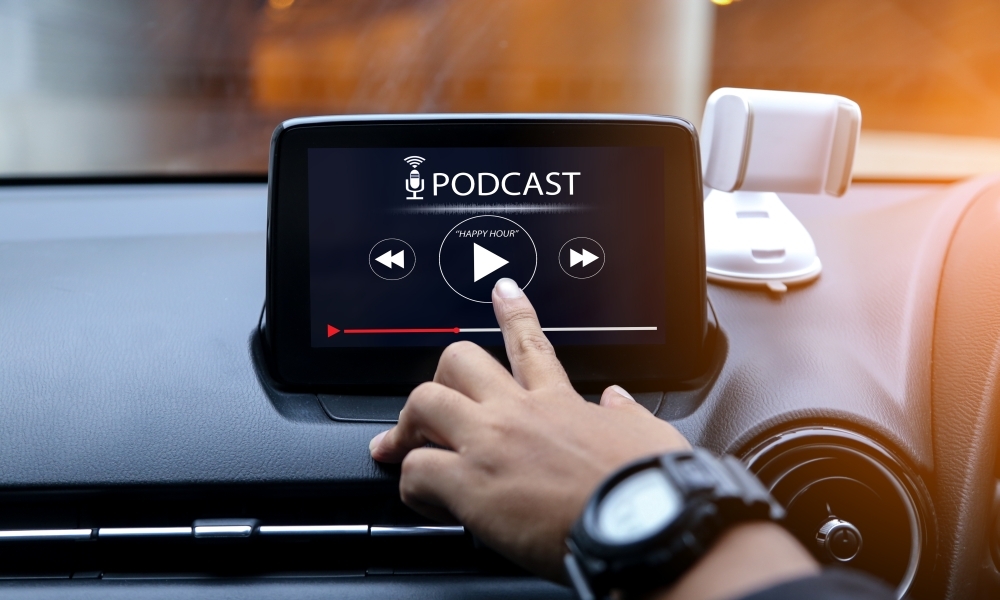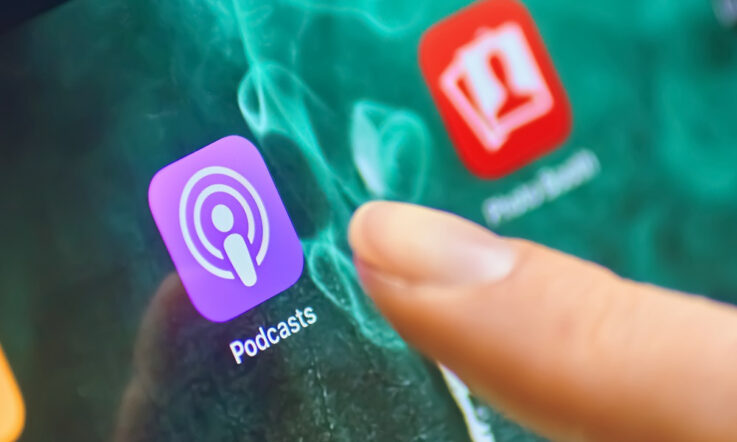Jo Earp: Hello and thank you for downloading this podcast from Teacher magazine – I’m Jo Earp.
Dominique Russell: And I’m Dominique Russell.
JE: Well, we made it – it still feels like 2020 to me actually, but anyway here we are in December 2021 and it’s time to look back at all of our podcasts from the last 12 months. Now we’ve got plenty to share today, and if you’re feeling like you need a break then the good news is there’s no audience participation needed … so get yourself a cuppa, sit back; leave the rest to us. Here we go then, with our 2021 highlights.
DR: It was certainly an interesting year of recording podcasts again for Teacher, wasn’t it? Swapping our recording studio for our home studio once again was definitely challenging at times I would say, especially when I moved homes to live on a main road halfway through the year … competing with that new traffic noise is definitely going to be an ongoing drama! But I think we got it through okay.
JE: Oh, I know what you mean. In our suburb we’ve got whipper snippers, mulching and chainsaws … and we’ve also got a new puppy in the house to contend with. And it wasn’t a podcast, but I remember doing an interview earlier this year, and we both had dogs in the background that were talking to each other via Teams! It was amazing.
DR: But, I have to say, the increased flexibility of being able to connect with people instantly from across the country and even across the world just by video call was definitely a plus. I got to speak with a researcher from Ireland for a podcast episode, Western Australia, Tasmania … the list goes on.
JE: That’s true, we’ve kind of been on another virtual tour again this year. So, the task for this episode then, as usual is to pick out our highlights. It has taken me a while to get it down to just three – so there’s definitely plenty of great listening in the archive in addition to these ones that we’re talking about today.
But I have to make a choice. So, my first pick is my chat with Bernadette Hawker, who’s Head of Department Teaching and Learning at Goondiwindi State High School up there in Queensland. This one is School Improvement Episode 34, and the focus is using Professional Learning Communities to improve student writing outcomes. So, the school has seen a massive turnaround in students’ results in writing over the last few years, thanks to a program that they developed called STEAM. And, the thing that really shone through in our interview was the culture of sharing that’s been developed at the school, and sharing the responsibility across different subject areas for improving writing. So in this clip that I’ve chosen, Bernie talks about the staff buy-in – she visited all Year 8 teachers and invited them to an initial planning meeting (which was voluntary, by the way).
They all came along, everyone from the ITD (Industrial Technology and Design) teacher, to the Phys Ed teacher to Science teacher to the Maths teacher – everyone who taught Year 8. And I showed them some data from a student that they all taught, and that child was failing every single subject. And it was a bit of an ‘aha moment’ because I think, collectively, they realised, and we all realised, that we are all responsible for this child’s learning and if they’re failing your subject and my subject and everyone else’s subject then we’ve all got to do something to help this child and every other child like that who is failing with their writing in our school. So that was kind of a moment where I had them, I felt, and my principal Brett says the same thing – and STEAM was born from there. We said ‘okay, what are we going to do?’ We came up with our name, they collaboratively came up with STEAM: Smart Teachers Enthusiastically Achieving More. We came up with our vision, with came up with our goals … we decided when we were going to meet, how often we were going to meet, how they wanted to do that. They decided Thursday mornings 8-8.30 once a fortnight and it kind of went from there.
DR: Yeah, we always talk about the ‘aha moment’ for students, don’t we, but it’s great to hear an example of staff experiencing it too and how useful that process can be. And I think as well, this is a great clip to highlight in our last episode of the year, because I think the concept of this STEAM program sounds like one that could be really key to starting off the new school year really well.
Onto my first pick now. Again, like you Jo, it was such a wide-ranging, fascinating group of people that I had the opportunity to speak with this year, so it was certainly really, really hard for me to choose just three episodes to highlight in this one now. I remember, for example, an episode we published back in May that sticks out to me. I spoke with some researchers about that they’ve work they’d done with schools to reduce carbon emissions just by changing simple behaviours – things like turning fridges off over the holidays and calling your water provider to check that your plan is actually appropriate. It was so interesting to hear them share the positive impact simple things like that can have on school budgets and also the positive effect it has on giving students agency to be involved in something as important as reducing emissions.
Another one that sticks out is an episode from our School Improvement series published way back in April and it was about how school leaders can improve confidence in music teaching in primary school settings. And the two researchers I spoke with, I remember, shared some lesson activities on creating soundscapes – which was really useful because they shared that their research showed that composition in particular is something generalist primary teachers tend to be least confident with.
Anyway, onto the picks that actually made my top three highlights. The first one that I’d like to share with you is going all the way back to the beginning of the year. It’s an episode in our Behaviour Management series which was published in February. We got to work on preparing this episode after trawling through our reader’s responses to our annual reader survey. So, in the survey, you might know we ask you to share one piece of advice you’d pass on to a fellow educator and we noticed that many of you were wanting to remind other teachers not to take a student’s behaviour personally, because it’s usually linked to a deeper issue a student’s facing.
So, in this episode I asked Senior Lecturer at Monash University, Dr Erin Leif, and PhD student and former primary school teacher, Russell Fox, to expand more on this idea. We explored how teachers can go about identifying the underlying causes of a student’s behaviour, and then approach responding to it in a really respectful and effective way. Here’s one small clip I’d like to share from Russell, which I thought might be useful to highlight for our listeners as they turn their attention to starting the new school year.
I just want to emphasise, just re-emphasise the importance of high quality effective instruction as a way to support student behaviour. There are times that behaviour’s getting in the way of students accessing the instruction that’s being delivered and, like you said Dominique, we need to monitor these plans over time. We actually need to be checking in to see how they’re progressing, because we should see progress in an effectively designed behaviour support plan. If we’ve done our job really well and we’ve got an accurate hypothesis, we should see behaviour improve.
JE: Yeah, that’s a useful reminder for the start of 2022 – the importance of continuing to monitor the effectiveness of interventions and programs that are put in place. That’s certainly something we talk about often in the podcasts, and in our articles. A reminder that, if you want to listen to the full interview with Dr Erin Leif and Russell Fox, it’s Episode 9 of our Behaviour Management series.
And now my second selection is actually an interview that our Deputy Editor Rebecca Vukovic did. Rebecca is currently on parental leave, so she can’t join us for this highlights episode. Her podcast with Dr Gary Stager is from August 2021, it’s Research Files Episode 69, and the topic is 30 years of laptops in schools.
So, Gary led the professional development in the world’s first 1:1 laptop school back in 1990. It really is a fantastic interview about what happened in those early days in Australian schools, who were actually the leaders, so definitely one to put on your summer listening list. In this snippet, Gary’s talking about one of the questions he’s often asked by educators around the world.
For 30 years, I’ve had schools fly me all over the world and they say ‘oh, great Oracle, may we ask you an important question?’ and one of the hard hitting questions I get posed is ‘what do we do about the kids playing games on the machines?’ And my answer is always the same, ‘ask them to stop’. But more importantly, the rule was … the kids could play any game they made. So the kids were involved in the mathematical thinking and the computer science and the problem solving and the design and the animation of the things that they created and they found themselves lost in those experiences. That typically when you have an assignment due at school, if you present it to the class, some kid presents something that is completely off the charts fantastic, probably done by or with a parent, and then the rest of the kids just sort of sink in their chairs and think to themselves, ‘oh geez, there goes the curve’. What we saw over and over again in the early laptop schools was, kids would say ‘that’s really cool’ and even if they turned the assignment in, they would continue working on what they had made because they wanted to make it bigger and they wanted to integrate the new knowledge that they had gained from somewhere else.
DR: Yeah, this was such a fascinating episode and such a great guest to have with the breadth of his experience on this topic. It was really, really interesting. My second highlight is also from The Research Files. I spoke with Hannah Yared, again from Monash University, about the literature review she conducted on racism and racial bias in Australian primary school contexts. In the episode she shared how teachers can confront their own racial biases; why it’s important to address racism with students when they’re in primary school rather than waiting until they’re older; and how school leaders have a crucial role in helping teachers feel more confident and competent in discussing racial issues in a meaningful way, which is something her review found teachers really struggle with. In this next clip, Hannah shares how school leaders can work to facilitate this:
And teachers need to feel as though this is something that’s really important to the school leaders and it’s kind of a non-negotiable that their school is going to engage in those things. And this includes leaders developing really clear anti-racism policies in their schools to assist in doing that effectively, to actually have a clear outline for teachers. And that especially relates to things like racist bullying, where it’s often dealt with in the same way as regular bullying and doesn’t account for that additional layer of discrimination based on skin colour and race. And also making sure that teaching materials and things like that – whether it’s books or texts or pictures around the classroom – making sure that all of those things are culturally responsive and reflect the diversity of students as well. So it really definitely needs to filter down from above.
JE: And the leadership aspect of this is so important – we’ve heard from other educators around Australia about successful programs, policies and strategies, and I think in every case the support of school leaders has been crucial to that. And, I also want to take a moment to highlight another piece of content – it’s an infographic that you did Dom on Aboriginal and Torres Strait Islander students’ self-reported experiences of direct racial discrimination in a school setting. I’ll put a link to that in the transcript of this podcast (which can be found at teachermagazine.com). The findings from that study, shared in our infographic, really are a stark reminder of the discrimination faced every day by some students here in Australia, so I’d also encourage you to take a look at that.
Okay, we’ve reached my final podcast selection now. It’s one that I did recently, just last month, with Dr Vaughan Cruickshank from the University of Tasmania – it’s from our Teaching Methods series and it’s all about delivering PE online. So, Vaughan talks about a study that he’s been involved with exploring teacher experiences of online delivery of PE during the COVID restrictions. One of the findings was that the subject was often seen as a bit of ‘filler’ or a break from other priorities, so things like literacy, numeracy and so on. So, there were some timetabling issues there, which we touch on in the episode. Also, just the support (or lack of it, actually) to implement this change to online in a subject area that does offer up lots of challenges. So, in this snippet, Vaughan’s talking about those challenges for teachers, and what happened.
Certainly in a lot of schools it appeared that the PE had been replaced with Physical Activity – so I guess they got PA instead of PE. And we certainly encourage students to be physically active, and resources like online fitness videos can be great for kids stuck inside during isolation, but PA by itself is not PE. So, the PA needs to be done in addition to PE lessons, where students are being taught concepts like Health Literacy, Critical Inquiry and provided with that feedback around how to refine skills and movement patterns. Because research tells us that development of those key, fundamental skills that allow students to be competent at being active are a really strong indicator of how active they’ll be throughout their lives. So that’s really important.
We did actually put in the paper that, obviously substituting Physical Activity for Physical Education long-term is going to be highly detrimental to achieving those HPE Curriculum aims around developing skills and dispositions for lifelong participation in physical activity. But it is important to acknowledge the lack of time and training that teachers were given to move online – so it’s probably a little bit unrealistic to expect them to have developed a really high-quality program.
DR: Yeah, I’m sure what Vaughan shared just there is something that would have been experienced by many school communities across the country in some capacity. And, how challenging must it have been to develop a high-quality program for PE during remote learning. I wonder if anyone listening to this podcast was part of facilitating a really high-quality Physical Education lesson plan during periods of remote learning? If that’s you, you can send us an email and share your story at teachereditorial@acer.org.
I’m onto my final highlight now and it’s again one that could be useful to refer back to at the start of the new school year. I caught up with Minami Uchida from Macquarie University to hear more about her research into the experiences of casual relief teachers (or CRTs) working in primary schools in Australia.
She had so many interesting findings from her survey that she did of CRTs. Many of them spoke about issues they faced to do with feelings of inclusion in the school community, behaviour management, but also things that they really liked about the role, like the flexibility. There was a clear highlight from this episode though, and it’s where Minami shares some strategies school leaders can implement to help CRTs feel more supported. Here’s what she had to say:
So we found there were three main practical strategies that can be integrated for casual teacher support. So they are inductions, having a classroom folder and informal mentoring. So in terms of inductions, that could be having hopefully about 10 to 15 minutes of the day in the morning to go through some of the important aspects of the school. Things like where the staffroom is, how to use a photocopier, if you’re even allowed to use the photocopier or if there’s a password, the bell times, details about playground duty and what sort of areas of the playground that you’re allocated to for the day. These sort of nitty-gritty, practical day-to-day details can mitigate anxiety for new casual teachers going to schools for the very first time. Even just having a sheet of paper with all of that outlined is such a great help.
JE: That was Minami Uchida from Macquarie University. If you want to listen to that interview in full it’s The Research Files Episode 66. A reminder that links to all the content we’ve discussed are in the transcript of this podcast at teachermagazine.com.
That’s it! That’s it for our highlights special, that’s it for the year. Thanks to all our guests and sponsors, and of course you, the listeners for all your support over the last 12 months and for being a part of the Teacher community. We’ll be back in January. If you’re new to Teacher, or you just want to do some binge listening over the holidays, you can access our full archive – that’s the Behaviour Management series, School Improvement, The Research Files, Teaching Methods, Action Research, Global Education, our monthly Teacher Staffroom catch ups, and the special episodes that we do. You just need to go to the podcast tab on teachermagazine.com or you can find us wherever you get your podcasts from. Don’t forget to hit that subscribe button, and I’ve just got a final favour to ask for 2021 – please rate and review us while you’re there. Take care and we’ll be back in 2022.



